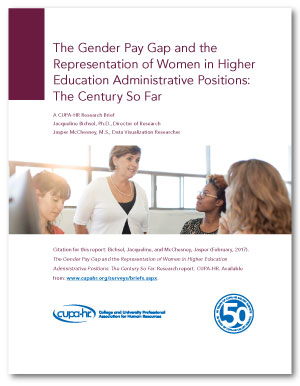By Missy Kline
CUPA-HR | February 14, 2017 —
While women have made gains over the past 15 years with regard to their representation in higher education administrative jobs, little progress has been made in narrowing the gender gap in top executive positions in the nation’s colleges and universities. In fact, according to new research from CUPA-HR, women occupy only 30 percent of the senior-most positions in higher education.
The study, which looked at how higher ed has paid women in administrative positions from 2001 through 2016, also found that in positions where women are less represented, they tend to be paid more. For example, although female chief facilities officers are outnumbered more than 9:1 by men, they earn 17 percent more than their male counterparts — perhaps indicating efforts to attract and retain women in these types of high-level positions. However, as a whole, women administrators earn on average 20 cents less than their male counterparts.
The Numbers
– In 2001, women administrators in higher ed earned approximately 77 cents on the dollar as compared to their male counterparts. Over 15 years, earnings have risen only slightly to approximately 80 cents in 2016. This pay gap roughly mirrors the overall U.S. pay gap for men and women.
– Across the U.S., about half of higher ed administrators are women. However, the representation of women decreases drastically in more prestigious, higher-paying jobs.
– Men outnumber women more than 2:1 among presidents and chief business officers and more than 4:1 among chief information officers and chief athletics administrators. The only executive position in which women occupy the overwhelming majority of positions is that of chief HR officer, where they outnumber men nearly 3:1.
Read the full research brief, , The Gender Pay Gap and the Representation of Women in Higher Education Administrative Positions: The Century So Far, and stay tuned for additional data on ethnic minority pay and representation in higher ed and a report on the top-performing institutions when it comes to pay and representation for women and ethnic minorities.










